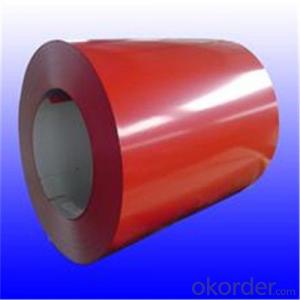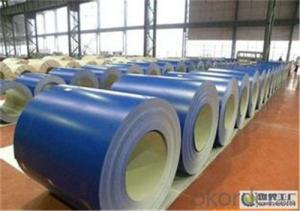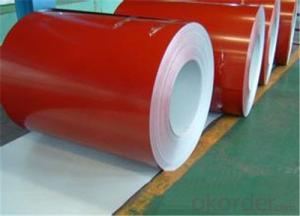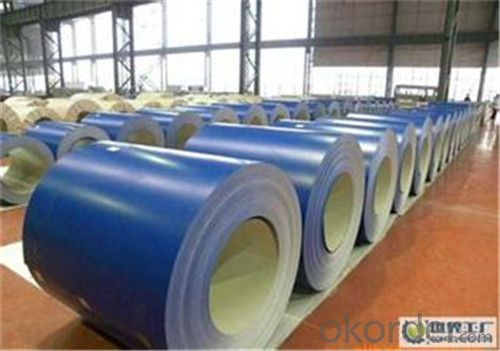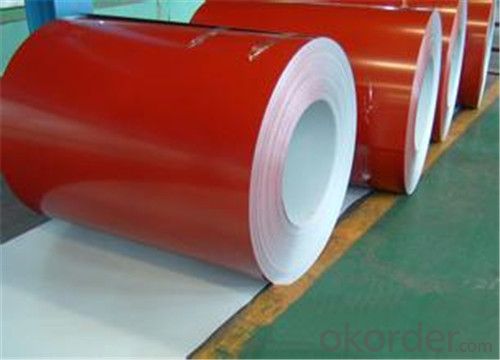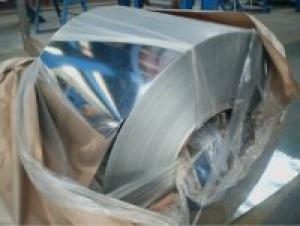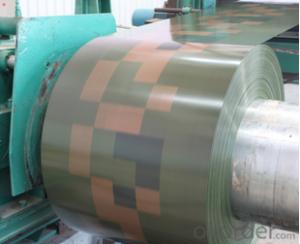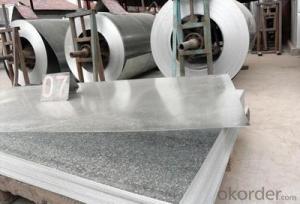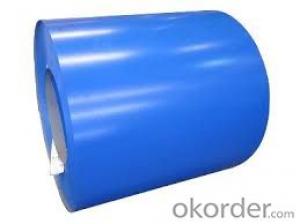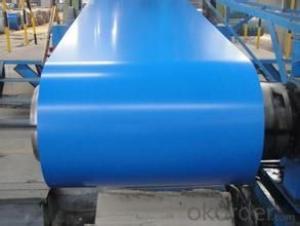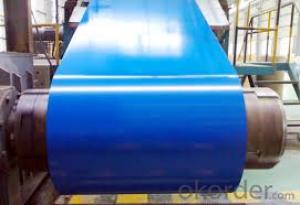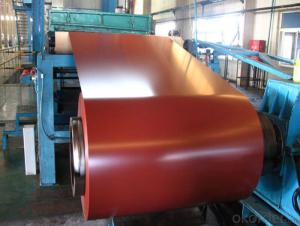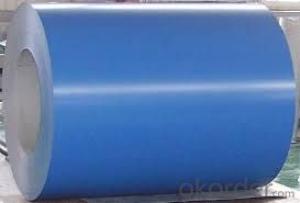Prepainted Galvanized rolled Steel coil/Sheet from china
- Loading Port:
- Tianjin
- Payment Terms:
- TT OR LC
- Min Order Qty:
- 100 m.t.
- Supply Capability:
- 500000 m.t./month
OKorder Service Pledge
OKorder Financial Service
You Might Also Like
Brief Introduction of Prepainted Galvanized Steel:
Prepainted Galvanized Steel usually refers to have substrate processed with surface processed and coated then(roller coated )or bonded organic thin film and baked, and it is able to be processed to final production .
Prepainted Galvanized Steel qualified with excellent decorative, formability, corrosion resistance, coating adhesion ,can keep for a long time as well as maintain fresh color .For color coated steel sheet can obtain good economic benefit by steel belt wood ,efficient in construction and save energy ,prevent pollution etc. Which is an ideal material; for manufacturing board.
Description of Prepainted Galvanized Steel:
1.material : galvanized steel sheet / prepainted galvanized sheet
2.sheet thickness : normal use 0.3-0.6mm
3.length: any length, according to the transportation, generally less than 12m
4.color: standard color: red, blue, white, grey; special color: according to RAL color
Specification of Prepainted Galvanized Steel:
prepainted corrugated steel plate | |
material | galvanized steel sheet |
prepainted galvanized sheet | |
model No. | types of roof sheets |
sheet thickness | normal use 0.3-0.6mm |
length | any length, according to the transportation, generally less than 12m |
color | standard color:red, blue, white, grey |
special color: according to RAL color | |
characteristic | 1:weather proof |
2:heating insulation | |
3:fireproof | |
4:anti-rust | |
5:sound insulation | |
6:long life span: more than 15 years | |
advantages | 1.low foundation cost |
2.easy construction | |
3.time saving | |
4.labor saving | |
application field | 1:construction:prefabricated house, steel house, mobile house, modular house, villa, bungalow design, portable house/carbin, ready made house, kiosk booths, steel building... |
2:container manufacturing | |
3:household appliances and furniture | |
4:vehicle and vessel manufacturing | |
5:others,like machinery structual parts, manufacturing shells of motors and so on | |
packing | plastic film, pallet or as your request |
Characteristic of Prepainted Galvanized Steel
It can be widely used in transportation, light industry, civil usage and farming. It is also the perfect building material in construction for making steel roofing, insulation panel, corrugate sheet, facade wall, shutters, T-bar and home appliance.
Packaging & Delivery of Prepainted Galvanized Steel
The packing of coils consists of anti-damp paper, PVC film, hardboard paper, steel box, strapped with steel strips, fitted with locks and edge protectors and guarantees the optimal condition of the delivered goods. Each coil can be additionally fitted with wooden/steel skids(eye to the side) or wooden pallets(eye to the sky).
Images of Prepainted Galvanized Steel:
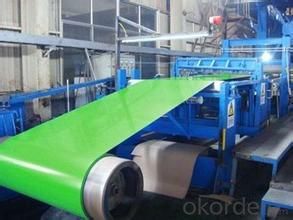
FAQ
1.What's your MOQ?
50MT, it is for one container.
2.Whether your company have QC teams?
Yeah, sure, our QC team is very important, they will keep the quality control for our products.
3. What's your normal delivery time?
Our delivery time about 10-20days for standard sizes, if you have other requirements like hardness and width ,it is about 20-40days. But don't worry ,we also try our best for the
- Q: Can steel coils be coated with QR codes?
- Yes, steel coils can be coated with QR codes. QR codes can be printed or engraved onto the surface of the steel coils, allowing for easy scanning and identification of the coils.
- Q: How are steel coils inspected for mechanical properties?
- Steel coils are inspected for mechanical properties through a series of tests and measurements. These include hardness testing, tensile testing, and elongation testing to determine the steel's strength, ductility, and overall quality. Additionally, non-destructive testing methods like ultrasonic testing and magnetic particle inspection are used to detect any potential defects or flaws in the coils. Overall, a combination of these inspection techniques ensures that steel coils meet the required mechanical properties for their intended applications.
- Q: Can steel coils be used in the production of medical equipment?
- Yes, steel coils can be used in the production of medical equipment. Steel is a strong and durable material that can provide structural support and stability to various medical devices and equipment. It is commonly used in the manufacturing of instruments, surgical tools, and machinery used in medical settings.
- Q: What are the different types of steel coil finishing machines?
- There are several different types of steel coil finishing machines, each designed to perform specific tasks and achieve desired results. Some common types include: 1. Slitting Machines: These machines are used to slit large steel coils into narrower strips of desired widths. They consist of a set of circular blades that cut through the coil as it passes through the machine, creating multiple smaller coils or strips. 2. Cut-to-Length Machines: These machines are used to cut steel coils into specific lengths. They can be programmed to make precise cuts at predetermined lengths, ensuring accuracy and consistency. 3. Recoiling Machines: Recoiling machines are used to rewind steel coils into tight, compact rolls. They are typically used to create smaller coils from larger ones or to rewound coils that have become loose or damaged. 4. Edging Machines: Edging machines are used to remove excess material from the edges of steel coils, improving their overall appearance and ensuring consistent width throughout the coil. 5. Coating Machines: These machines are used to apply various coatings or finishes to the surface of steel coils, such as paint, galvanized coatings, or protective films. They often incorporate drying or curing systems to ensure proper adhesion and durability of the applied coatings. 6. Packaging Machines: Packaging machines are used to wrap or package steel coils for transportation or storage. They can wrap the coils in protective materials, such as plastic or paper, and secure them with strapping or other fastening methods. 7. Inspection Machines: These machines are used to inspect the quality and integrity of steel coils. They can detect defects, such as cracks, scratches, or surface irregularities, and provide feedback for quality control purposes. These are just a few examples of the different types of steel coil finishing machines available. Each machine serves a specific purpose in the steel coil finishing process, ensuring that the final product meets the desired specifications and quality standards.
- Q: Molten steel changes to solid steel at its __________ point. Could you please fill in the blank? Thank you so much, it is greatly appreciated. I have been looking for the answer to this question for a long time, but I never understand what the websites are trying to say because I don't have that big of a vocabulary and don't know what they mean. I've seen things saying steel boiling point, steel melting point, and steel freezing point. I don't know what any of those mean, and they might be the answer. Please help me. Thank you.
- Carbon 'tempers' steel, by making it harder and less prone to bending (ductility). It fits the carbon atoms into the spaces in between the crystal lattice structure of the iron atoms. Too much carbon means the steel becomes more brittle, harder to weld and thus more likely to shatter under stresses which are perpendicular (shear forces) to the crystal structure of the molecules. It also is very difficult to work, requiring very high temperatures.
- Q: What are the different coil slitting methods used for steel coils?
- Steel coils can be slit into smaller, narrower coils using various methods. These methods serve the purpose of cutting the coils to suit specific applications. 1. The most commonly used method for coil slitting is blade slitting. Circular knives or blades are employed to cut the steel coil into narrower strips. These blades are placed at predetermined intervals and usually attached to a rotating shaft. As the coil passes through the blades, their circular motion slices through the coil, resulting in the desired narrower strips. 2. Another method, known as rotary shear slitting, involves the use of two sets of rotary shear knives to cut the steel coil. These upper and lower sets of knives rotate in opposite directions, creating a scissor-like cutting action. As the coil is fed through the shearing blades, the sharp edges of the knives slice through the coil, producing the desired narrower strips. 3. Sliding shear slitting is yet another method utilized for coil slitting. This method involves a stationary upper knife and a moving lower knife to cut the coil. The lower knife moves back and forth across the coil while the upper knife remains fixed. As the coil passes through the moving knife, it is cut into narrower strips. 4. Crush slitting is a less common method employed for coil slitting. In this method, the steel coil is fed through a set of rollers equipped with blades. Although the blades are not sharp, the pressure exerted by the rollers crushes and fractures the coil, resulting in the creation of the desired narrower strips. 5. Laser slitting is a modern and precise method used for coil slitting. It utilizes a laser beam to cut through the steel coil. The laser beam is directed onto the coil, and its high intensity melts and vaporizes the steel, creating a narrow slit. Laser slitting offers high accuracy and a clean cut, making it suitable for specialized applications. Each of these coil slitting methods possesses its own advantages and limitations. The choice of method depends on factors such as the type of steel, desired strip width, production volume, and required precision. Manufacturers select the most suitable method based on their specific requirements and the properties of the steel coils they are processing.
- Q: How are steel coils processed for edge conditioning or slitting?
- Steel coils are processed for edge conditioning or slitting through a series of steps. First, the coil is unwound and flattened to remove any bends or curls. Then, the edges of the coil are trimmed or conditioned to ensure a smooth and straight edge. After that, the coil is slit into narrower strips using specialized machinery. This process allows for the production of various widths of steel strips, which can be used for different applications.
- Q: What is the difference between hot rolled and cold rolled steel coils?
- The main difference between hot rolled and cold rolled steel coils is the process by which they are made. Hot rolled steel coils are produced by heating the steel above its recrystallization temperature, allowing it to be easily shaped and formed. This process results in a rougher surface finish and less precise dimensions. On the other hand, cold rolled steel coils are produced by further processing hot rolled coils through a series of rolling mills at room temperature. This process results in a smoother surface finish, tighter tolerances, and improved mechanical properties.
- Q: How are steel coils used in the production of storage racks and shelving?
- Steel coils are used in the production of storage racks and shelving by being processed into flat sheets or strips, which are then formed, shaped, and welded to create the various components of the racks and shelves. The strength and durability of the steel coils make them ideal for supporting heavy loads and ensuring the stability and longevity of the storage racks and shelving systems.
- Q: How are steel coils used in the manufacturing of pressure vessels?
- Steel coils are used in the manufacturing of pressure vessels as they provide a strong and durable material for constructing the vessel's shell. The coils are typically rolled and welded to form the cylindrical shape of the pressure vessel, ensuring high structural integrity and the ability to withstand high pressure.
Send your message to us
Prepainted Galvanized rolled Steel coil/Sheet from china
- Loading Port:
- Tianjin
- Payment Terms:
- TT OR LC
- Min Order Qty:
- 100 m.t.
- Supply Capability:
- 500000 m.t./month
OKorder Service Pledge
OKorder Financial Service
Similar products
Hot products
Hot Searches
Related keywords
